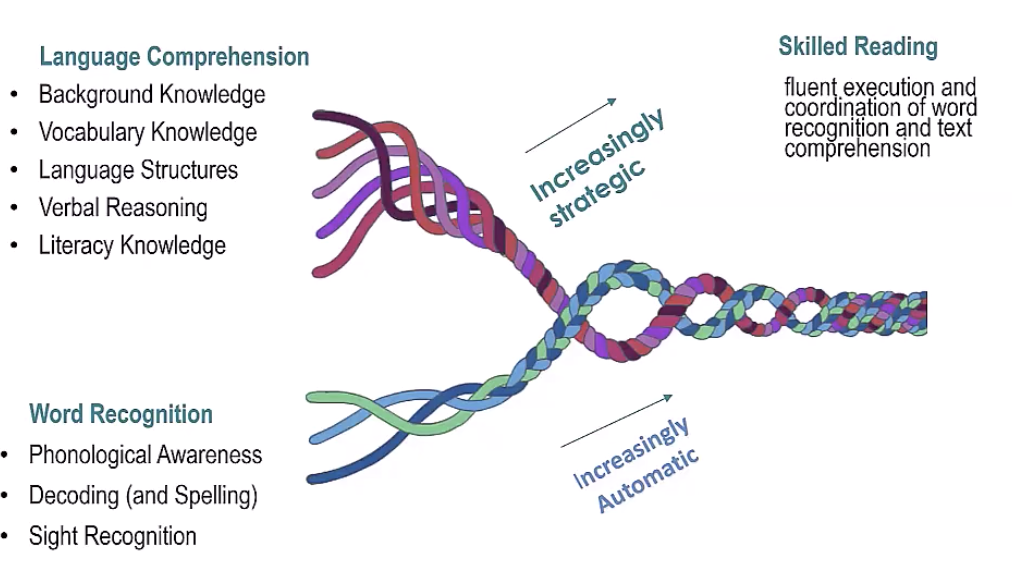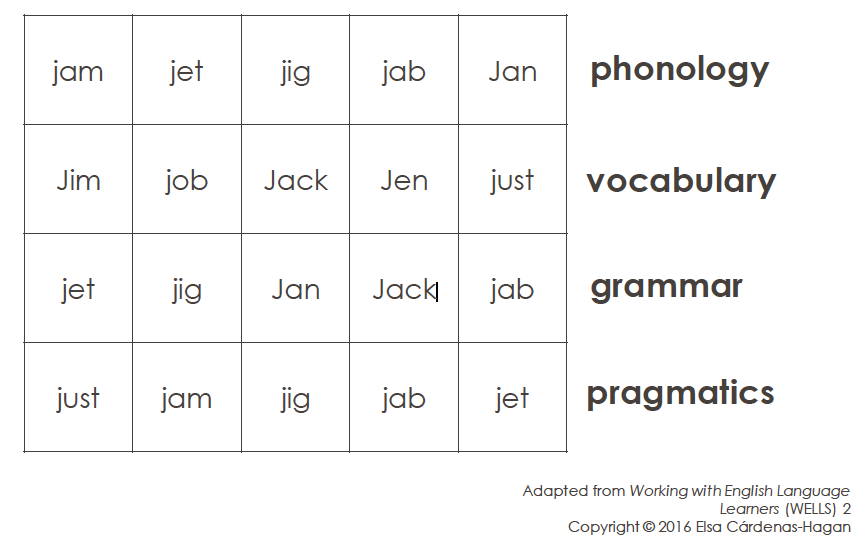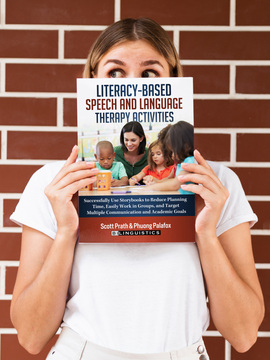Structured Literacy Intervention for ALL Students
Dr. Elsa Cárdenas-Hagan’s gave a workshop on how SLPs can incorporate structured literacy components into their intervention to support all students—especially those from diverse backgrounds who speak English as an additional language. Below, we highlight some of the elements that she shares about a structured literacy approach.
Structured Literacy is a comprehensive, evidence-based approach to literacy instruction that encompasses key components for teaching literacy, including phonological awareness, phonics, fluency, vocabulary and comprehension.
How do we tie language to literacy?
As speech-language pathologists, part of our role is incorporating literacy instruction into our speech and language intervention for children with Development Language Disorders. In this post, we’ll share ideas for an integrated approach to language and literacy instruction, demonstrating ways we can address all components of language at the same time. Additionally, we’ll consider the added components that need to be taken into account for the bilingual students we serve.
Reading is Language-Based
The components of structured literacy are language-based. The key areas of reading instruction include:
- Phonological awareness
- Phonics
- Reading Fluency
- Vocabulary
- Comprehension
Why is it important that we talk about structured literacy with bilingual students?
There are more than 5 million students in the United States who have a home language other than English. We have more than 400 different home languages in the United states. To help them achieve their highest academic potential, we need to encourage their abilities to be able to communicate and be biliterate in their homes, at school, and in their communities.
How can we adapt structured literacy programs when a student does not speak the language of the school?
We need to use the home language if at all possible.
- Important research. Did you know that children who are learning English as an additional language who have the ability to work on literacy skills in their home language or heritage language perform better than those who do not.
We need to build upon the cross-linguistic features.
- We can help our students to become metalinguistic by teaching them to use cross-linguistic features in a very systematic and sequential manner
Institute of Educational Sciences Practice Guide
The National Academies of Sciences, Engineering and Medicine produced a Consensus produced a report in 2017 called Promoting the Educational Success of Children and Youth Learning English that notes the importance of incorporating a number of elements in intervention. You can download a free PDF of this report using the link above.
There is consensus that we should provide explicit instruction in structured literacy components that include:
- phonemic awareness
- phonics
- oral reading fluency
- vocabulary
- reading comprehension
- writing
The Simple View of Reading
In Dr. Cárdenas-Hagan’s course, she walks us through the Simple View of Reading
Decoding x Language Comprehension = Skilled Reading (Gough & Tunmer, 1986)

Next, she walks us through Dr. H. Scarborough’s enhanced this model, in which skilled reading is fluent execution and coordination of word recognition and text comprehension. Dr. Scarborough includes the components of language comprehension and word recognition that lead to skilled reading, which she defines as “fluent execution and coordination of word recognition and text comprehension.”
Here are the components of Scarborough’s model.
Language Comprehension
- Background knowledge
- Vocabulary knowledge
- Language structures
- Verbal reasoning
- Literacy knowledge
Word Recognition
- Phonological Awareness
- Decoding (and Spelling)
- Sight Recogntition

Structured Literacy
Dr. Cárdenas-Hagan then moves to focus on Structured Literacy, which was a term defined at the International Dyslexia Association 2014 by the board of that group.
What is Structured Literacy?
- It is integrated instruction that emphasizes:
- The structure of language
- The speech sound system (phonology)
- The writing system (orthography)
- The structure of sentences (syntax)
- Meaningful word parts (morphology)
- Meaning (semantics)
- The organization of spoken and written discourse for deep reading and effective written communication.
- The other aspects of cognition related to literacy acquisition, such as attention skills.
What about Structured Multiliteracy (Cárdenas-Hagan, 2014)
Structured Multiliteracy includes everything involved in structured literacy in addition to the understanding of all features in both languages, and an understanding of the similarities and differences of linguistic features and sounds across languages.
Integrated Teaching of Language Skills
Listening, speaking, reading and writing skills are integrated components of a system and should be taught that way. When we try to separate them, our approach is disjointed. Rather than have a dedicated phonological awareness time and later a dedicated phonics time, integrate them into the same structured literacy language lesson.
Speech-language pathologists are accustomed to integrating the components of language through narrative interventions, where we address semantics, pragmatics, syntax, phonology, and morphology all in the same lesson. We can also easily incorporate writing and reading into the same lessons. Highlighting morphemes, such as ‘-ed’ indicated a past tense form helps a child with reading fluency, writing, and comprehension. It also helps to support reading fluency. It’s an integrated system and teaching it that way supports our students’ learning.
When students are familiar with the syntax of the language, they can more easily predict which word will come next, which facilitates their reading fluency. When we teach about context and culture, students’ understanding of a passage increases.
Bilingualism/Multilingualism and Integration of Language Skills
Children who are growing up with more than one language also have to learn their systems in integrated fashion. Truth is, their two (or more) languages are also integrated. They have things that overlap and things that are unique to each language. When students start school where English is the primary language spoken and they are coming from a different language background, they might spend a short time listening and not talking. This is referred to as the silent period. Not all students go through it but some do. Once they start to talk, they might produce single words or short phrases before moving to produce sentences. As they go through the stages, they might make grammatical errors in English but we really should consider these “errors” to be natural patterns of their home language influencing their second language. When two language features differ across the child’s two languages, it’s common for them to use patterns from their home language in their English productions as they are learning the language. This is a normal process of bilingual language acquisition.
Resources for Understanding Language Patterns in Different Languages
In order to better understand the varying features across languages, we’d like to share a few resources with you. When we know the sounds and features that exist in the child’s native language, we can think of those as assets that they bring to their English learning. For example, if two languages have 20 consonant phonemes in common, and the language the student is learning has 30 consonant phonemes, there are only 10 additional phonemes to learn. These are assets, and English learner who speaks a language other than English as their native language, comes to the table with assets. As educators, we need to know what those are. Here are some resources to help you.
Difference or Disorder: Understanding Speech and Language Patterns in Children from Culturally and Linguistically Diverse Backgrounds (paperbackor ebook)
- This book compares and contrasts English with 12 of the most frequently spoken languages in U.S. It provides Venn diagrams of the consonant and vowel phonemes, easily showing what sounds the languages have in common, and which sounds are unique to each language. It provides developmental information about sounds and language features. And it provides a contrastive language chart to show similarities and differences in language features across the two languages. For more details on using the book, there are two online courses that provide instruction on the difference or disorder approach. Difference or Disorder as it relates to speech and Difference or Disorder as it relates to language.
Dr. Cárdenas-Hagan shared a website with us called MyLanguages, where educators can find information about a wide range of languages.
Integrated Structured Literacy Approach with a Focus on Phonological Awareness
- Focus on a particular sound (j)
- Change the sound in words to and show meaning change with visual supports (ham to jam)
- Provide friendly word definitions
- Make a connection to the home language (what word do you use to say jam in your home language?)
- Use the word in a complete sentence
An Integrated Structured Literacy Approach to Reading Practice
Dr. Elsa Cárdenas-Hagan shared this chart from her book Working with English Language Learners (WELLS) 2, (2016).

Still focusing on the sound “j” we can incorporate phonology, vocabulary, grammar, and pragmatics as follows:
- Phonology –
- Read a word that rhymes with…
- Read the word that ends with…
- Vocabulary
- Read a word that means…
- Read the word that is the antonym of…
- Syntax
- Read a word that is a verb
- Read a word that is an adjective
- Pragmatics
- Read a word you would use with your friends but not your teachers.
- Read a word that has more than one meaning.
For many more examples and details on this structured literacy intervention, check out Dr. Elsa Cárdenas Hagan’s course. She shares the stages involved in second language acquisition and excellent guidelines for educating bilingual students learning English as an additional language. She focuses on high quality, differentiated language and literacy teaching that is culturally relevant and provides meaningful opportunities for students to practice listening, speaking, reading, and writing in an integrated fashion during structured literacy intervention.




